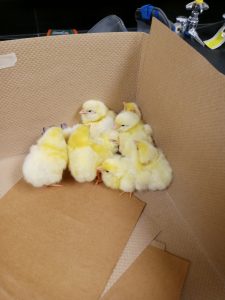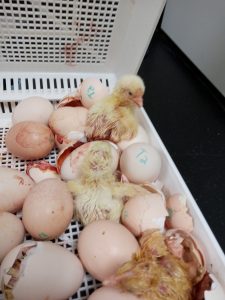By: Dr. Oscar Tejeda, M.Sc., Ph.D.
Assistant Professor of Poultry Science, SAU Department of Agriculture
Introduction
About 95% of the total broiler production happens in family-owned farms. In general, growers receive chicks from local hatcheries; however, in some occasions, broiler farms can be located several hours away from the nearest hatchery, requiring of long periods of transport before chicks are placed in the farm which can lead to impairment of chick quality and post-hatch performance. In order to prevent impairment of chick quality and improve growth performance at the farm, it is important to know about the factors that need to be controlled during transport. Therefore, the work reported herein points out at important environmental parameters and techniques that can help improve chick transport and improve post-hatch performance.
Generalities of transport
There are several factors affecting transport of chicks to the farm. Factors such as environmental temperature, relative humidity (RH), the use of environmentally controlled trucks/buses, distance, and time during the day. Chicks will, preferably, be transported in environmentally controlled trucks/buses that allow for the control of temperature, relative humidity, and ventilation.

Most chick transport is done using buses with the capacity of 50,000 chicks or climate-controlled vans with the capacity of 100,000 chicks. There are seasonal differences to account for to guarantee chick comfort and reduce dehydration.
Environmental temperature
The outside or environmental temperature has profound implications on the density at which newly hatch chicks will be transported. As a general rule of thumb, chick buses can transport 36,000-44,000 chicks during the winter and 26,000-32,000 chicks during the summer time. Climate-controlled vans can transport 100,000 chicks during the winter time and 80,000 during the summer time. These changes in numbers are given due to the fact that high stocking densities tend to increase the heat generated and can provoke suffocation due to the lack of fresh air. Environmental temperature and duration of transport go hand in hand. Ideally, chicks should not be transported in high stocking densities during summer time for long periods of time. During the summer, it is important to prevent the hotter hours whenever possible to prevent dehydration and stress due to such temperatures. In extreme conditions foggers can be implemented to help in the cooling down of the truck and prevent chick dehydration.
Duration of transport
Even though the yolk provides nutrients to the newly hatched chick for several hours after hatch, a good number of chicks will be several hours old when they are pulled out of the hatcher machine. The normal hatching curve is found between 24-48 hours which indicates that some chicks will be depleted of their nutritional reserves even before being loaded in the bus/truck to be transported and in most cases, chicks will have access to water and feed until they arrive to the farm.

Long feed and water deprivation have been shown to impair growth performance and development of the immune system in chicks (Simon et al., 2015; Uni and Ferket, 2019). Furthermore, late access to feed increases the changes for hypothermia. Therefore, for best results, chicks should not be transported for periods longer than 3 hours and in situations when there is not alternative for long transport, early nutrition should be practice. The method of early nutrition provides feed and water to the newly hatched chicks and has proven to increase the post-hatch performance, especially during the first two weeks of age (Hollemans et al., 2018).
Temperature during transport
During the first two weeks of age, chickens lack the ability to thermo-regulate or to maintain a constant body temperature. Therefore, during transport, chicks must be exposed to a temperature around 89-91 °F depending on the relative humidity. It is critical to point out the fact that temperature does not mean anything by itself, but it has to be evaluated together with different values of relative humidity. In general, the higher the relative humidity, the temperature required will be in the lower range, whereas, the lower the relative humidity, the temperature required will be in the higher range.
Relative humidity during transport
In general terms, relative humidity refers to the water vapor content in the air. This value decreases with higher temperatures and increases with lower temperatures. Relative humidity plays a major role affecting the rate of dehydration in chicks. In general, low values of relative humidity increase water loss as evaporation of water through the skin tries to generate an equilibrium with the water content in the air. It is known that a chick can lose around 0.25% of body weight per hour under normal conditions. When relative humidity is lower than 60% during transport, higher body water loss can be expected and dehydration will be eminent. Loses of 5-7% can cause metabolic problems and induce long-term physiological problems associated with poor performance and finally death of the birds.
| RH, % | 30% | 40% | 50% | 60% | 70% |
| Temperature, F | 93.2 | 91.4 | 89.6 | 97.8 | 86 |
Ventilation during transport
Ventilation is important to provide a homogenous temperature during transport, to remove gases produced by the chicks (i.e. CO2), and to remove excess of heat (during summer). If air is not replaced in the enclosed environment in which the chicks are transported, changes in air composition happen. The concentrations of CO2 increase to toxic levels. Recommended CO2 levels are < 2,000 ppm and build up can happen when ventilation is poor. As the ventilation increases, there is higher exchange of CO2 for O2 that is required to sustain metabolism of the newly hatch chicken. Ideally, the truck in which the chicks are being transported will contain a carbon dioxide-meter to guarantee chicks are exposed to adequate conditions.
Other techniques that could be used
#1 Teaching chicks to drink water
It is important to remember the fact that newly hatch chicks don’t have mother hen to lead them to water nor feed. Therefore, whenever possible, you can take several chicks per house and “teach them to drink water” by using their beaks to activate the nipple drinkers (or dip their beaks in bell drinkers). This technique is surprisingly efficient and can decrease the time between chick placement and chicks drinking water up to 30-50%. This is important because every second counts during the first days of life of the newly born chicks.
#2 Hatching eggs on the farm
There is research pointing out at the possibility of hatching chicks at the farm. This new concept tries to prevent all the stress newly hatched chicks are exposed to during long periods of transportation. When using this technique, fertile eggs are moved to the grow-out barn on embryonic day 18 for hatching to occur on the farm omitting several hatchery procedures and transport of 1-day old chicks. This procedure has shown to increase hatchability, and reduce number of second grade chicks. However, considerations regarding the transport of chicken eggs have to be considered before using such methods.
References
Simon, G. de Vries Reilingh, J.E. Bolhuis, B. Kemp, A. Lammers. 2015. Early feeding and early life housing conditions influence the response towards a noninfectious lung challenge in broilers. Poult. Sci., 94:2041-2048.
Uni, R.P. Ferket. 2019. Methods for early nutrition and their potential. Worlds Poult. Sci. J., 60:101-111.
Jessen, C. T., L. Foldager, A. B. Riber. 2021. Effects of hatching on-farm on performance and welfare of organic broilers. Poult. Sci. 100:101292
Hollemans, M. S., S. de Vries, A. Lammers, C. Clouard. 2018. Effects of early nutrition and transport of 1-day-old chickens on production performance and fear response. Poult. Sci. 97:2534-2542.
